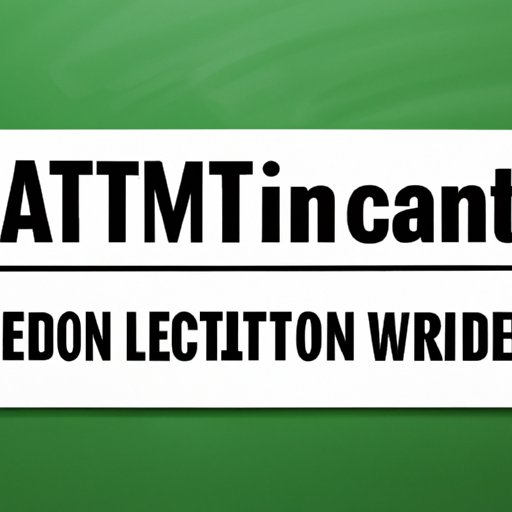Introduction
Alternative minimum tax (AMT) is a tax system imposed by the federal government to ensure that high-income earners and corporations pay their fair share of taxes. AMT limits the eligibility for deductions and credits, which means that individuals and companies may pay more taxes than they would under the regular tax system.
It’s important to minimize AMT because it can significantly increase your tax liability. The good news is that there are several strategies that you can implement to reduce your AMT and save money on taxes. This article will provide a beginner’s guide to understanding AMT and offer practical tips for minimizing your tax liability.
Understanding AMT: A Beginner’s Guide to Minimizing Your Tax Liability
AMT is a tax system that limits the eligibility for certain deductions and credits to ensure that high-income earners and corporations pay their fair share of taxes. The AMT rate is either 26% or 28% depending on your income level.
To determine if you owe AMT, you must calculate both your regular tax liability and your AMT liability. The tax liability that is higher is the one you must pay. AMT can be complicated and confusing, but with the right guidance, you can minimize your tax liability.
Who is subject to paying AMT? Individuals or corporations who make over a certain income threshold and have high deductions and credits are the ones subject to paying AMT.
The reason why AMT exists is to ensure that high-income earners and corporations pay their fair share of taxes. The regular tax system has certain loopholes that allow high-income earners and corporations to pay fewer taxes. AMT closes these loopholes and ensures that everyone pays their fair share of taxes.
To calculate AMT, you must add back certain deductions that are allowed under the regular tax system. Some of these deductions include state and local taxes and certain items of miscellaneous deductions.

Top 5 Strategies for Minimizing Your AMT
Now that you understand what AMT is, here are some top strategies for minimizing your tax liability:
1. Maximize Retirement Contributions
Maximizing retirement contributions can lower your taxable income and reduce your AMT liability. Traditional IRA and 401(k) contributions can reduce your taxable income, which can help lower your AMT.
Drawback: Contributions to retirement accounts usually have limits, and you may need to balance it with other deductions and credits to maximize tax savings.
2. Take Advantage of Charitable Giving
Contributions to qualified charities can help reduce your taxable income and lower your AMT liability. Keep detailed records of all charitable contributions, including cash and non-cash donations.
Drawback: There are specific rules regarding charitable donations, and charitable giving should not interfere with your overall financial goals and objectives.
3. Time Your Capital Gains and Losses
Timing your capital gains and losses can help minimize your AMT liability. Consider selling assets when it makes the most sense regarding your overall tax plan.
Drawback: Timing your capital gains and losses is an art, and a misstep can lead to unintended tax consequences.
4. Maximize Your Business Expenses
Self-employed individuals or small business owners can maximize their business expenses to reduce their taxable income and lower their AMT liability. Keep detailed records of all business-related expenses.
Drawback: You must ensure that all expenses are legitimate business expenses, or this could lead to an audit.
5. Create a Family Limited Partnership (FLP)
A family limited partnership (FLP) can be an effective tool to minimize AMT liability. FLPs are entities that hold family-owned assets, and income is distributed among the members according to their ownership percentage.?
Drawback: FLPs have specific rules and regulations that must be followed to ensure they are legitimate and not used for tax evasion purposes.
The Hidden Costs of AMT and How to Reduce Them
AMT presents several hidden costs that can significantly increase your tax burden. These may include loss of deductions, an increase in tax liability, and lack of tax planning flexibility. Here are some ways to reduce the impact of AMT:
The Biggest Challenges of AMT and How to Overcome Them
The biggest challenges of AMT are the lack of tax planning flexibility and its complexity. To overcome these challenges, you should work with a qualified tax professional who has extensive knowledge and experience in AMT. A qualified tax professional can help you create a tax plan that minimizes your AMT liability and maximizes your overall tax savings.
Cost-Savings Measures to Reduce the Impact of AMT
Cost-savings measures to reduce the impact of AMT include reducing your taxable income, delaying tax payments, and diversifying your portfolio. By implementing these measures, you can reduce the impact of AMT and keep more money in your pocket.
Don’t Let AMT Catch You Off Guard: 6 Ways to Decrease Your Tax Burden
To avoid feeling caught off guard, it is essential to understand how AMT works and take precautions to minimize your tax liability. Here are some tips to decrease your tax burden:
1. Plan Ahead
Planning ahead is key to reducing your tax burden. Work with a qualified tax professional to create a tax plan that minimizes your AMT liability and maximizes your overall tax savings.
2. Keep Accurate Records
Accurate record-keeping is essential when it comes to minimizing AMT. Keep detailed records of all income, expenses, and deductions.
3. Avoid Timing Your Deductions
Avoid timing your deductions as this may increase your AMT liability. Instead, focus on maximizing your deductions throughout the year through smart tax planning.
4. Do Not Count on Refunds
Do not count on refunds to reduce your tax liability. Instead, focus on minimizing your tax liability by maximizing deductions and credits throughout the year.
5. Work with a Qualified Tax Professional
Work with a qualified tax professional with extensive knowledge and experience in AMT to help create a tax plan that minimizes your AMT liability and maximizes your overall tax savings.
6. Consider Tax-Loss Harvesting
If you are subject to AMT, tax-loss harvesting can help reduce your tax liability. Tax-loss harvesting involves selling securities at a loss, which can help offset any capital gains and reduce your AMT liability.
AMT Minimization: Expert Tips for High-Income Earners
High-income earners face specific challenges when it comes to AMT. Here are some expert tips for minimizing your AMT liability as a high-income earner:
An Understanding of How High-Income Earners Can Mitigate AMT
High-income earners can mitigate AMT by limiting their deductions and credits, maximizing their retirement contributions, and using FLPs to hold family-owned assets. By implementing these strategies, high-income earners can help reduce their AMT liability and lower their tax burden.
Strategies That Cater Specifically to High-Income Earners
Strategies that cater specifically to high-income earners include maximizing your charitable giving, creating a donor-advised fund, and using a non-grantor trust. By implementing these strategies, high-income earners can help reduce their AMT liability and lower their tax burden.

The ABCs of AMT Reduction: A Simple Guide to Lowering Your Taxes
To reduce your tax liability, follow these simple steps:
A. Analyze Your Tax Situation
Examine your income, deductions, and credits to understand your tax liability. Analyzing your tax situation will help you identify areas where you can reduce your tax liability and increase your overall savings.
B. Boost Your Deductions
Maximize your deductions to reduce your taxable income and lower your tax liability. Work with a qualified tax professional to identify and maximize your deductions.
C. Create a Tax Plan
Create a tax plan that minimizes your AMT liability and maximizes your overall tax savings. Work with a qualified tax professional who has extensive knowledge and experience in AMT.
Conclusion
Minimizing AMT requires planning and action. By implementing the strategies laid out in this article, you can reduce your tax liability and keep more money in your pocket. Remember, understanding AMT is the beginning of minimizing your tax liability.
